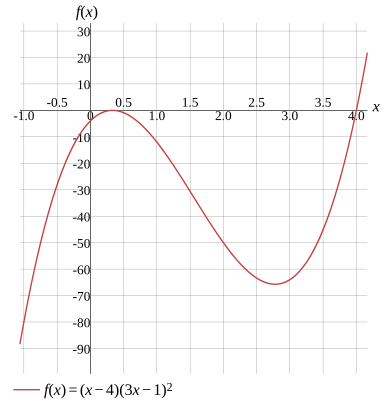Question
Function
Evaluate the derivative
Find the domain
Find the x-intercept/zero
Load more

f′(x)=27x2−84x+25
Evaluate
f(x)=(x−4)(3x−1)2
Take the derivative of both sides
f′(x)=dxd((x−4)(3x−1)2)
Use differentiation rule dxd(f(x)×g(x))=dxd(f(x))×g(x)+f(x)×dxd(g(x))
f′(x)=dxd(x−4)×(3x−1)2+(x−4)×dxd((3x−1)2)
Calculate
More Steps


Calculate
dxd(x−4)
Use differentiation rule dxd(f(x)±g(x))=dxd(f(x))±dxd(g(x))
dxd(x)−dxd(4)
Use dxdxn=nxn−1 to find derivative
1−dxd(4)
Use dxd(c)=0 to find derivative
1−0
Removing 0 doesn't change the value,so remove it from the expression
1
f′(x)=1×(3x−1)2+(x−4)×dxd((3x−1)2)
Calculate
f′(x)=(3x−1)2+(x−4)×dxd((3x−1)2)
Calculate
More Steps


Calculate
dxd((3x−1)2)
Use the chain rule dxd(f(g))=dgd(f(g))×dxd(g) where the g=3x−1, to find the derivative
dgd(g2)×dxd(3x−1)
Use dxdxn=nxn−1 to find derivative
2g×dxd(3x−1)
Calculate
2g×3
Substitute back
2(3x−1)×3
Multiply the terms
6(3x−1)
Apply the distributive property
6×3x−6×1
Multiply the numbers
18x−6×1
Any expression multiplied by 1 remains the same
18x−6
f′(x)=(3x−1)2+(x−4)(18x−6)
Calculate
f′(x)=(3x−1)2+18x2−78x+24
Simplify
More Steps


Evaluate
(3x−1)2
Use (a−b)2=a2−2ab+b2 to expand the expression
(3x)2−2×3x×1+12
Calculate
9x2−6x+1
f′(x)=9x2−6x+1+18x2−78x+24
Solution
More Steps


Evaluate
9x2−6x+1+18x2−78x+24
Add the terms
27x2−6x+1−78x+24
Subtract the terms
27x2−84x+1+24
Add the numbers
27x2−84x+25
f′(x)=27x2−84x+25
Show Solution

Testing for symmetry
Testing for symmetry about the origin
Testing for symmetry about the x-axis
Testing for symmetry about the y-axis
Not symmetry with respect to the origin
Evaluate
f(x)=(x−4)(3x−1)2
Rewrite the function using the appropriate notation
y=(x−4)(3x−1)2
To test if the graph of y=(x−4)(3x−1)2 is symmetry with respect to the origin,substitute -x for x and -y for y
−y=(−x−4)(3(−x)−1)2
Simplify
More Steps


Evaluate
(−x−4)(3(−x)−1)2
Multiply the numbers
(−x−4)(−3x−1)2
A negative base raised to an even power equals a positive
(−x−4)(3x+1)2
−y=(−x−4)(3x+1)2
Change the signs both sides
y=(x+4)(3x+1)2
Solution
Not symmetry with respect to the origin
Show Solution

Graph
